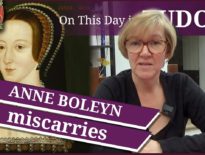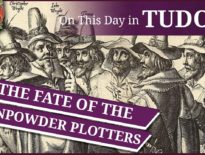On this day in Tudor history, 28th January 1598, diplomat Edward Barton died of dysentery on the island of Heybeli Ada, in the Sea of Marmara, off the coast of Istanbul. Barton and his predecessor, William Harborne, had played key roles in Elizabeth I's alliance with the Ottoman Empire.
Elizabeth I had a good relationship with the Islamic World and it was something that was very important to her. Find out why Elizabeth reached out to the Ottomans in the 1580s, and just how the relationship worked, in today's talk.
Recommended reading: "This Orient Isle: Elizabethan England and the Islamic World" - Jerry Brotton
Also on this day in Tudor history, 28th January 1457, Henry VII was born and in 1547 his son, Henry VIII, died. See my video from last year:
Also on this day in history:
- 1501 – Death of John Dynham, 1st Baron Dynham, politician and administrator, at Lambeth. He was buried at the London Greyfriars on 30th January. His offices included Lord High Treasurer of England, Lord Chancellor of Ireland, Lieutenant of Calais and High Sheriff of Devon.
- 1521 – Opening of the Diet of Worms, which ran from 28th January to 25th May 1521 with Charles V, Holy Roman Emperor, presiding over it. Reformist Martin Luther was summoned to the imperial diet to renounce or reaffirm his beliefs, and he appeared there on 16th April. On 25th May 1521, the Edict of Worms was issued by the Emperor denouncing Luther and calling for him to be punished as a heretic. It offered a reward to anyone who could capture him.
Transcript:
On this day in Tudor history, 28th January 1598, diplomat Edward Barton died of dysentery on the island of Heybeli Ada, in the Sea of Marmara, off the coast of Istanbul. He was buried on the island in the Christian cemetery.
Barton was just thirty-five years old at the time of his death, but had had quite a career. He worked his way up from serving merchant and ambassador, William Harborne, as his assistant and secretary, in Istanbul, known as Constantinople then, when Harborne was working there as agent of the Turkey Company of Merchants and first English ambassador, to succeeding Harborne in both those positions when Harborne left in 1588. Although he’d been recognised as ambassador by the Ottoman Empire from 1588, it took until 1593 for him to be officially granted the title of ambassador by Elizabeth I. His biographer, Christine Woodhead, explains that the delay was “caused largely by the necessity to send a suitably expensive present (on this occasion mainly of garments and lengths of cloth) without which it was unlikely that his official credentials would be favourably received.”
Barton was very useful in Turkey, more useful than many other agents sent there, because he could speak Turkish, and so could deal directly with the Ottomans.
Elizabeth I had a very positive relationship with the Ottoman Empire and this alliance was sensible following her excommunication from the Catholic Church, which isolated her from Catholic Europe. Her excommunication also freed her and English merchants from the pope’s ban from trading with what he called the Infidel. As Jerry Brotton, author of “This Orient Isle: Elizabethan England and the Islamic World”, points out, the Ottoman Empire was a 16th century global superpower, which, like Elizabeth, had been condemned as heretical by the papacy. In 1578, Elizabeth I’s advisor and spymaster Sir Francis Walsingham recommended Elizabeth sending a merchant to also act in an ambassadorial role to Constantinople, that man was William Harborne, Edward Barton’s boss, and he was sent to Turkey in 1579.
Here are a few facts about diplomacy between Elizabeth I and the Ottomans at this time:
• Harborne’s first mission was to help set up trading between Turkey and England, and in 1581, Elizabeth gave royal assent to the Levant Company, or Turkey Company, to do this.
• Historian Jerry Brotton explains that William Harborne and his men, like Edward Barton, were accepted in Turkey by the Ottomans as “dhimmi (‘zimmi’), protected guests who paid a tax to remain unmolested in Muslim territory.”
• Much to Spain’s fury, England shipped cloth for soldiers’ uniforms and scrap tin and lead taken from the roofs and bells of deconsecrated Catholic churches and monasteries to Constantinople, where it was then turned into munitions. The Ottomans then used these in their wars against Spain and the Shia Persian Empire. In return, she received spices, pistachio nuts, currants, Turkish carpets, ceramics, damasks, and embroideries. Elizabeth did the same with the Barbary States, swapping metals for gold and sugar, and with Morocco she sent ship timbers in exchange for saltpetre.
• Between 1585 and 1587, Sir Francis Walsingham wanted Harborne to persuade the Sultan to attack the Spanish fleet in the Mediterranean to try and prevent them from attacking England. They didn’t do this, but Harborne’s diplomacy did prevent a peace treaty between the Ottomans and Spain.
• Elizabeth I had a good relationship with Sultan Murad III throughout the 1580s, and it was also a political alliance. Both of them saw Spain as the enemy, with Elizabeth seeing Spaniards as idolatrous Catholics who falsely professed the name of Christ, and feeling that she had more in common with the Ottomans. The Sultan called her Sultana Isabel and viewed England’s Protestantism as “the most sound religion” in Christianity. Elizabeth sent him an elaborate mechanical clock “beset with jewels”. Above it “was a forest of trees of silver, among which were deer chased with dogs, and men on horseback following, men drawing water, others carrying mine ore in barrows: on top of the clock stood a castle, and on the castle a mill. All these were of silver.”
• In 1588, it was Edward Barton who encouraged the queen to correspond with, and send gifts to, Walide Safiye, the Sultana, which she did from 1593. The first gifts were “a jewel of her majestie’s picture, set with some rubies and diamants, 3 great pieces of gilt plate, 10 garments of cloth of gold, a very fine case of glass bottles silver and gilt, with 2 pieces of fine Holland.” The Sultana reciprocated with a gown of cloth of gold, an undergown of cloth of silver, and a girdle of Turkish work. Elizabeth continued corresponding with her after Murad’s death, when Walide’s son became Sultan. Later gifts from Elizabeth included a clockwork musical organ and a beautiful carriage. Wow! I’d love to see those gifts!
• By the 1580s, as well as having Harborne and Barton in Turkey, Elizabeth had consuls throughout the Middle East and North Africa.
• Barton’s boss, William Harborne, signed the first English alliance with the Sultan, known as the Capitulations. This alliance remained in place until 1922 when the Ottoman Empire fell. According to the terms of this alliance, English merchants could trade freely throughout Ottoman territories.
• Jerry Brotton notes that in the late 16th and early 17th century, 62 plays contained Islamic characters, themes or settings due to England’s links with the Muslim world, including William Shakespeare’s Othello, the Merchant of Venice, and Titus Andronicus.
I love how pragmatic Elizabeth I could be and how she turned her excommunication into a positive. They do say that the enemy of your enemy is your friend, and it was so true in this instance. It may have been a beneficial relationship in terms of trade and politics, but it was also a relationship of mutual respect. Good on Elizabeth.
Further Reading
- Sultana Isabel
- Elizabethan England's relationship with the Islamic World
- This Orient Isle: Elizabethan England and the Islamic World - Jerry Brotton
- Elizabethan England was obsessed with Islam
- Gloriana Rules the Waves: Or, the Advantage of Being Excommunicated (And a Woman), Lisa Jardine, Transactions of the Royal Historical Society, Vol. 14 (2004), pp. 209-222, https://www.jstor.org/stable/3679316?seq=1



This was really interesting! How cool is it that the treaty created 320 some of so years ago lasted so long. I’ll add that book to my list, too. Thanks! Michelle t
It’s amazing, isn’t it?!